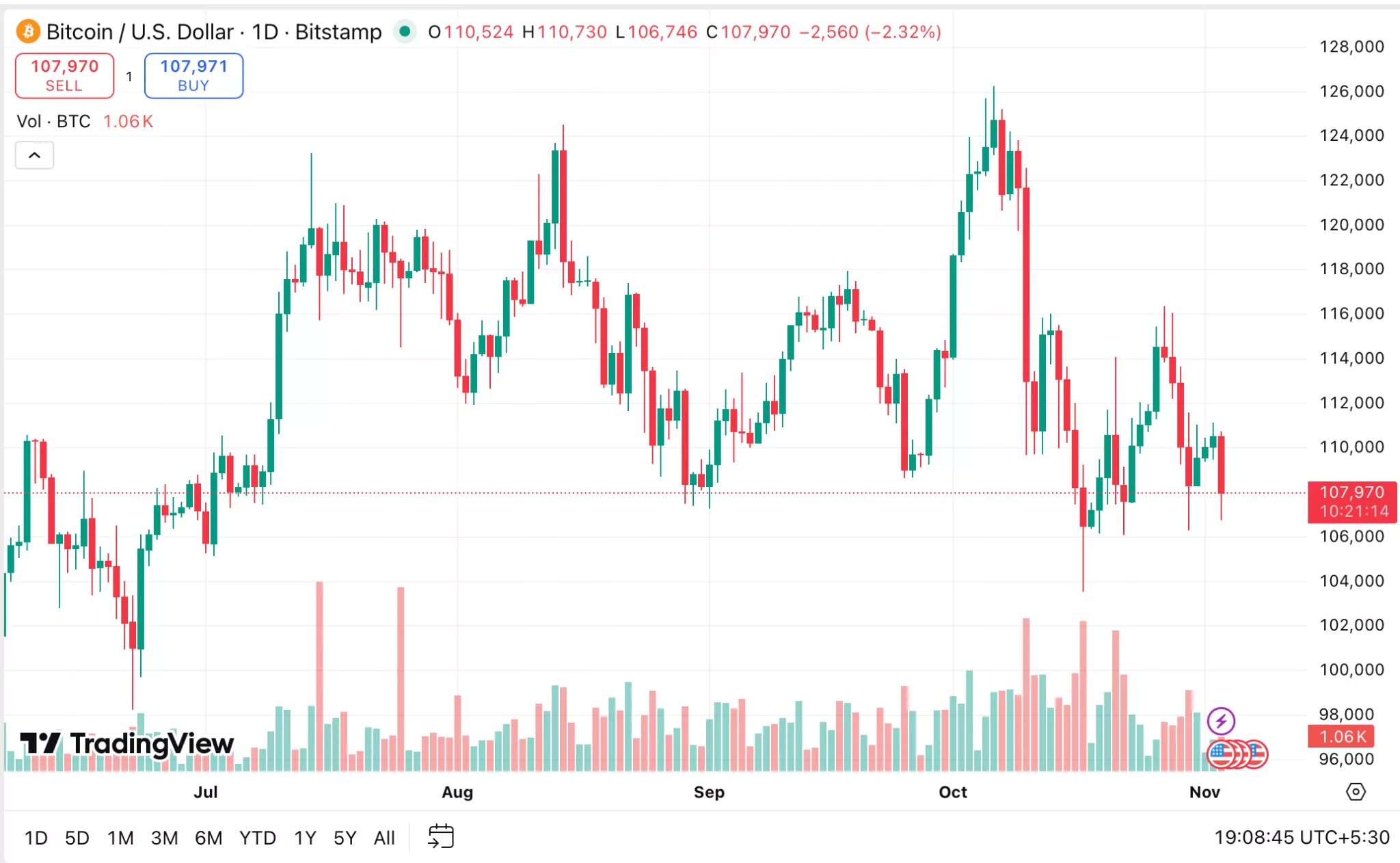Will Bitcoin price be able to regain momentum after October's reversal, or will the fourth quarter remain at its lowest since 2022?
summary
- After hitting $126,000 in early October, Bitcoin prices fell nearly 15%, ending the winning streak and weakening heading into the fourth quarter.
- Bitcoin fell to around $108,000 as trade tensions between the U.S. and China, a strong dollar, and slowing Fed easing weighed on the market.
- Central banks added liquidity and eased tariffs to calm markets, but the impact was short-lived as investors remained cautious until early November.
- Analysts currently see key support for Bitcoin at $107,000, warning that a break below could trigger further losses in an already fragile fourth quarter.
table of contents
Bitcoin price sets new record of continuous increase
Bitcoin entered October with confidence and continued its strong rally, pushing the price to an all-time high of over $126,000 on October 6th. Then a sharp and sudden fall occurred.
Within days, the price fell by more than 17%, reaching about $104,500 between October 10 and 11. The month ended with Bitcoin (BTC) declining approximately 3.6%, marking the first negative October since 2018. As of November 3, Bitcoin is trading around $108,000, about 14.5% below its monthly high.

BTC price chart |Source: crypto.news
This decline was due to several related global developments. The US-China trade conflict intensified after Washington imposed 100% tariffs and introduced new restrictions on software exports. This move triggered massive liquidations across the crypto market and weakened investors' risk appetite.
At the same time, the Fed signaled it may slow the pace of rate cuts. This stance strengthened the dollar, made high-yielding assets more attractive, and put further pressure on Bitcoin, which doesn't generate interest or dividends.
Another factor is Bitcoin's deeper integration with traditional finance. In past cycles, Bitcoin has often moved independently of global markets. Currently, institutional trading, ETF flows, and broader macro sentiment are shaping its direction far more than retail activity alone.
As a result, 2025 ended the “Uptober” streak. Bitcoin has fallen nearly 6% so far in the fourth quarter, marking the weakest start to what is typically a strong month for cryptocurrencies since 2022. The question now is what lies ahead as the market deepens into November and the rest of the fourth quarter.
Liquidity tightens due to trade ceasefire
In early November, a sense of relief appeared to be coming to global markets. Following a meeting between President Donald Trump and President Xi Jinping in South Korea, the two countries agreed to a broad trade ceasefire framework that represents a partial de-escalation of the trade war that escalated earlier this year.
Under the agreement, China will begin lifting a ban on exports of automotive computer chips, which include components vital to global car production, addressing a major bottleneck that has disrupted global manufacturing chains.
The two sides also reached an agreement on U.S. soybean exports, with China agreeing to purchase 12 million tons this season and 25 million tons annually for the next three years.
The framework also includes cooperation on the supply of rare earth minerals and precursor materials used in the production of the drug fentanyl.
The US will reduce tariffs on Chinese goods from 57% to 47%, while China has agreed to postpone export restrictions on rare earths, gallium and germanium for one year.
But despite the political view of progress, China's manufacturing industry continues to struggle. The country's manufacturing PMI stood at 49 in October, extending the streak of contraction to seven months and indicating continued weakness in global demand and production.
In the United States, the Federal Reserve Board (Fed) moved slightly toward monetary easing, lowering its benchmark interest rate by 25 basis points to a range of 3.75% to 4.00% at its October 28-29 meeting.
The decision came as the unemployment rate edged up from 4.0% to 4.3%, while inflation remained at about 3% year-on-year. Fed Chairman Jerome Powell reiterated that future policy remains dependent on data and that markets currently expect a 70% chance of another rate cut in December.
A similar move was made by the US central bank. On October 31, the Federal Reserve injected $29.4 billion in liquidity through its largest overnight repo operation since 2020.
Federal Reserve injects $29.4 billion into U.S. banks through overnight loans – largest since early 2020
— NewsWire (@NewsWire_US) November 1, 2025
For Bitcoin and the broader crypto market, increased liquidity, lower tariffs, and easing trade tensions create a theoretically supportive backdrop, but the actual recovery will depend on whether supply chains and credit conditions stabilize sufficiently to restore investor confidence.
Ruling that could shake up Bitcoin
The next big test for global markets, and indirectly for Bitcoin, is set to unfold at the US Supreme Court. On November 5, the Trump administration will confront small businesses and several U.S. states that have challenged the legality of tariffs imposed earlier this year under the International Emergency Economic Powers Act of 1977.
Plaintiffs argue that the president exceeded his constitutional authority because the law allows for emergency trade restrictions but does not explicitly authorize tariffs. The court's decision is expected to be handed down between March and June 2026.
The lawsuit includes about $90 billion in import taxes already collected through September 2025, according to Wells Fargo estimates. But government officials have warned that the amount could rise to as much as $1 trillion if the court takes until June 2026 to rule, and the tariffs remain in place in the meantime.
If the courts rule against the administration, these tariffs could be invalidated and ordered back, potentially upsetting the fiscal balance and causing volatility in the dollar and stocks.
If the decision favors the White House, it would strengthen the executive branch's ability to unilaterally impose or adjust tariffs and give the U.S. president far more flexibility in trade negotiations.
This legal showdown presents a complex scenario for Bitcoin and the broader crypto market. While this asset was once famous for moving independently of traditional markets, it now behaves more like a macro-linked financial instrument.
Over the past few years, Bitcoin's correlation with the S&P 500 and Nasdaq Composite has risen sharply, especially during periods of policy-driven volatility.
If the Supreme Court decision shakes confidence in U.S. trade policy or the dollar weakens, speculative funds could return to risk assets, potentially temporarily supporting virtual currency prices.
Conversely, a ruling that tightens administrative controls and stabilizes the dollar could put pressure on Bitcoin as investors return to traditional safe-haven assets.
Analysts’ outlook and Bitcoin’s next move
Market sentiment remains divided on where Bitcoin will go next. Analyst Ted Pillows noted that Bitcoin is testing the $107,500 support level for the third or fourth time in just two weeks, a pattern often seen before a definitive breakout or breakout.
$BTC plunged towards the $107,500 support level.
This is my third or fourth retest in just two weeks, which is not a good sign.
If Bitcoin cannot sustain this level, it will only be a matter of time before we see a retest of $100,000. pic.twitter.com/gGxk1nmbgB
— Ted (@TedPillows) November 3, 2025
He warned that failure to sustain this range could open the door to a retest of the $100,000 mark, which has served as Bitcoin's psychological and technical foundation for much of 2025.
Repeated tests suggest that while buying power near $107,000 is waning, short-term volatility could spike if that level breaks.
On a more macro level, analyst Plan B, known for his stock-to-flow model, highlighted that Bitcoin closed at $109,000 in October, marking the sixth consecutive month above $100,000. He sees this range as consolidating long-term support rather than forming a short-term ceiling.
Bitcoin’s monthly RSI is 66, which is a solid upward trend.
Full analysis in this video 👉 https://t.co/vxrFSNWtGS pic.twitter.com/dDWU8wiEa1
— PlanB (@100trillionUSD) November 2, 2025
According to his model, Bitcoin's realized price is currently around $56,000, with a 55-day moving average of about $55,000. In his view, these levels form a structural bottom reminiscent of the early bull markets of 2013, 2017 and 2021.
Plan B also noted that the Relative Strength Index was 66, suggesting a strong uptrend but not yet in the overheating zone that historically precedes market highs.
Based on his stock-to-flow forecast, Bitcoin's fair value ranges between $250,000 and $1 million, although he acknowledged there is a lot of uncertainty about timing and peaks.
While bulls believe that FOMO does not exist and that the divergence between realized price and moving average is steadily diverging towards the next expansion phase, bears argue that Bitcoin may have already peaked at $126,000 after the halving cycle.
Overall, Bitcoin's short-term direction will largely depend on whether the $107,000-$108,000 zone holds. A breakdown below this could cause a sharper correction, while stability above that level could set the next leg higher.
For now, the market is still overheated, so proceed with caution and never invest more than you can afford to lose.
Disclosure: This article does not represent investment advice. The content and materials published on this page are for educational purposes only.

